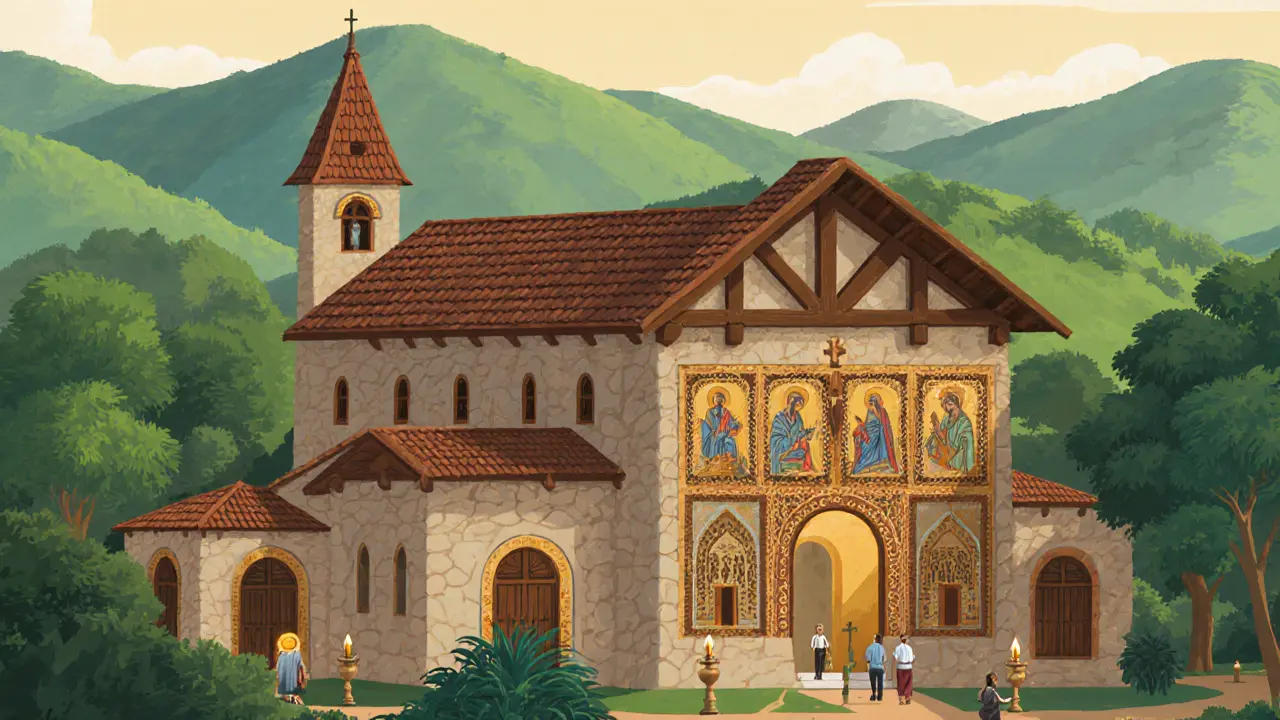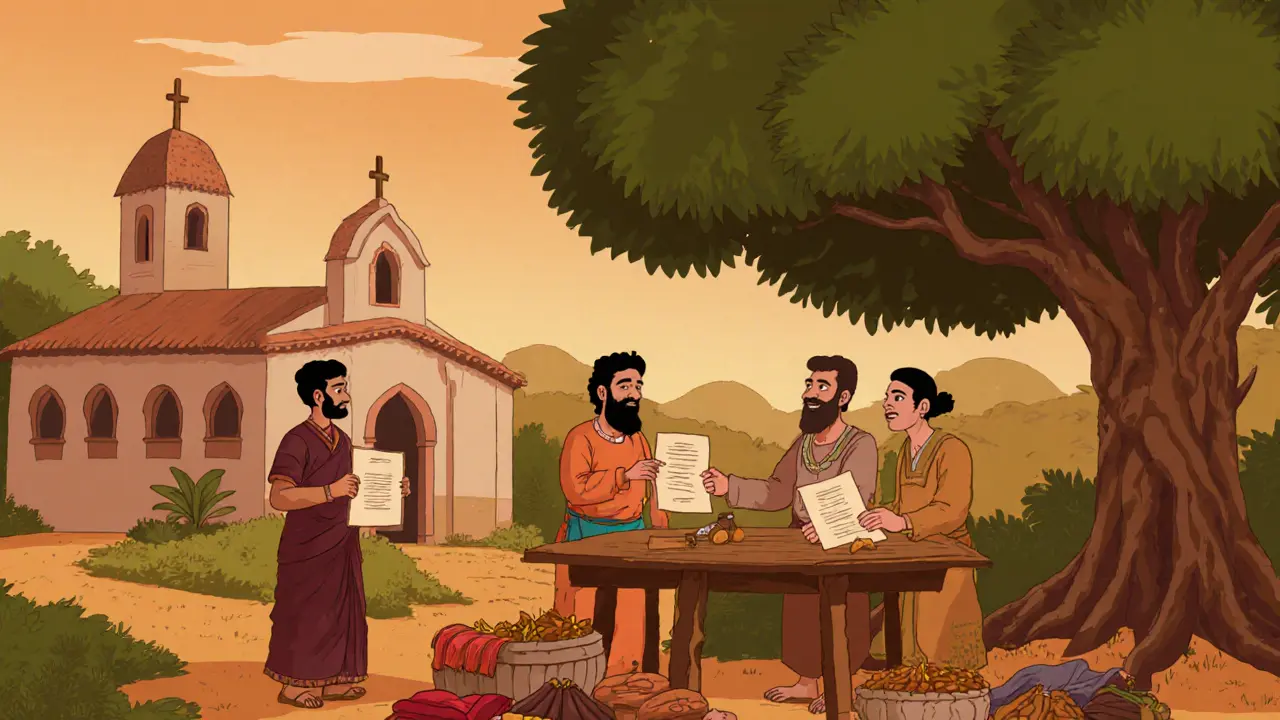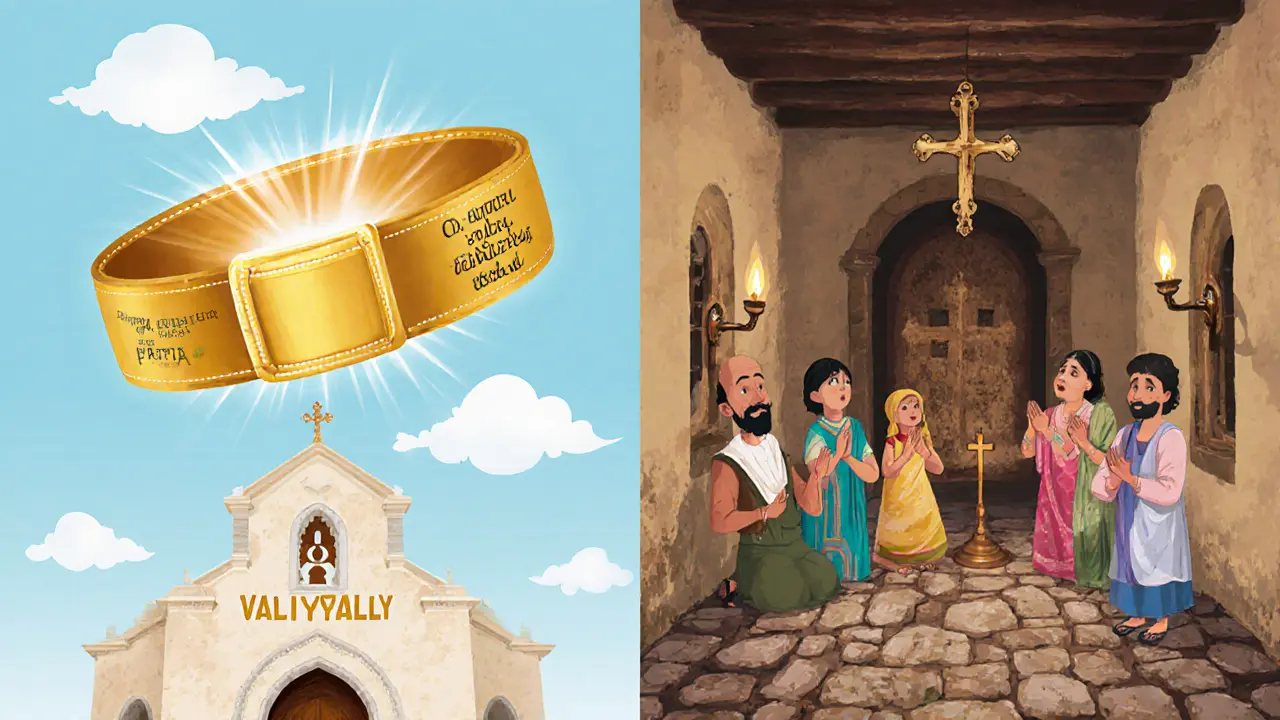
There’s a church in Kothamangalam, Kerala, that’s been standing for nearly 700 years. Locals call it Valiyapally - the Big Church. It’s not just old. It’s one of the few churches in India that traces its roots back to a time when Christianity in India was still shaped by ancient Syrian traditions, long before European missionaries arrived. The building sits on a quiet hilltop, surrounded by green hills and the hum of daily life. Inside, the walls hold centuries-old murals, stone inscriptions in Syriac, and a quiet sense of continuity that few places in the world can match.
Who Built It, and When?
The story of St. Mary’s Jacobite Syrian Cathedral starts with traders, not missionaries. In 1338 or 1340, four Syrian Christian merchants from the Malabar coast bought the entire land of Kothamangalam from a local chief. Their goal? To set up a trading post for goods moving between Kerala and Tamil Nadu. But they didn’t just build a warehouse. They built a church. That’s how Valiyapally began - not as a place of conquest, but of community.
Some say the church goes back even further - to the 4th century - when Syrian Christian families from Paravur and Angamali settled here. Others link it to the Knanaites, a group that arrived in AD 345 under Thomas of Cana. But historians and researchers, including those behind the Syriac Christian Monuments of Kerala blog, lean toward the 1338 date. Why? Because when multiple founding stories exist, the later one is often the one tied to physical evidence - like land deeds, architectural styles, or written records from the time.
What we know for sure is this: Valiyapally survived Portuguese colonization, Tipu Sultan’s invasions, and the split in the Malankara Church after the Coonan Cross Oath in 1653. It didn’t just survive - it kept going. Today, it’s still the main church of the Kothamangalam diocese under the Malankara Jacobite Syrian Church. The current leadership includes Archbishop Aboon Mor Baselios Joseph and Bishop Mor Yulios Elias, who oversee its daily life and spiritual direction.
What Makes the Church Special?
Valiyapally isn’t just old. It’s architecturally unique. It blends the traditional Kerala style - wooden beams, sloping roofs, open courtyards - with Syrian Christian liturgical needs. The interior has thick stone walls, hand-carved crosses, and murals of biblical scenes painted in earth tones that have lasted for centuries. You won’t find stained glass or towering spires here. Instead, you’ll find quiet spaces for prayer, incense hanging in the air, and the sound of Syriac chants echoing during liturgy.
It’s not a museum. It’s alive. Every Sunday, families come for the West Syriac Rite Mass. Children sing in the choir. Elders light candles. The church runs schools, feeding programs, and charity drives. It’s a center for identity - not just religious, but cultural. The Jacobite Syrian Christian community in Kerala, which makes up about 15-20% of the state’s Christian population, sees Valiyapally as a living link to their ancestors.
Just down the hill is Marthoma Cheriapally, the Small Church. Built in 1455 by 18 families who split off from the original congregation, it’s a quiet reminder that even in faith, differences arise - and still, both churches remain part of the same deep-rooted tradition.

The Holy Belt Myth: Heiliger Gürtel, Sacra Cintola, Cinto de Tomé
Now, here’s where things get tangled - and where misinformation spreads.
Some websites and travel blogs claim that St. Mary’s Cathedral in Kothamangalam houses the Heiliger Gürtel (Holy Belt), the Sacra Cintola (Holy Girdle), or the Cinto de Tomé - the very belt said to have been given by the Virgin Mary to the Apostle Thomas at her Assumption. The story goes that Thomas carried it from Jerusalem to India, and it’s now hidden inside this church.
It sounds powerful. It sounds biblical. But it’s not true.
The real Sacra Cintola is in Prato, Italy. It’s been there since the 13th century, displayed in a chapel within Prato Cathedral. The tradition is well-documented in Italian religious history, with pilgrimages, relics, and even Renaissance paintings dedicated to it. There’s zero credible evidence - no church records, no Portuguese colonial documents, no Syriac manuscripts - linking this relic to Kothamangalam.
The Syriac Christian Monuments of Kerala blog, which has visited over 234 historic churches in the region between 2015 and 2018, makes this clear: most sites claiming direct ties to St. Thomas’s first-century presence are modern commemorations. They’re built to honor legend, not to preserve archaeology. The blog’s author points out that many churches in Kerala, including twin churches in Karakunnam, were actually built in the 1800s but given 14th-century dates to boost their spiritual prestige.
That doesn’t mean the stories aren’t meaningful. They’re deeply woven into the identity of Kerala’s Syrian Christians. St. Thomas is their patron. His journey to India is their origin myth. But conflating that myth with a specific relic from Italy? That’s a case of cultural blending gone too far - often fueled by tourism brochures or poorly researched YouTube videos.
Why Does This Myth Persist?
Because people want to believe.
There’s something powerful about touching the past. About standing where the apostles stood. About holding a piece of the divine. In a world full of uncertainty, relics offer comfort. They make history feel real.
But in Kothamangalam, the real relic isn’t a belt. It’s the church itself. The stone floor worn smooth by centuries of bare feet. The Syriac prayers still spoken the same way they were in 1400. The fact that the same families have attended here for 20 generations.
That’s the true miracle. Not a belt from heaven. But a community that refused to let its faith die.

What You’ll See If You Visit
If you go to Valiyapally today, you won’t find a glass case labeled “Holy Belt of Thomas.”
You’ll find:
- Stone inscriptions in Syriac script near the altar
- Murals of the Annunciation and the Last Supper, painted in natural pigments
- Old wooden pews, still used every Sunday
- A small museum with ancient crosses, liturgical books, and vestments from the 1800s
- A peaceful courtyard where people sit quietly after Mass
The church doesn’t need a relic from Italy to be sacred. Its history, its people, its unbroken chain of worship - that’s the relic.
Visitors come from across Kerala for the annual feast of the Assumption of Mary. Thousands gather. The church is lit with oil lamps. Chants rise into the night. It’s not about proving a miracle happened 2,000 years ago. It’s about celebrating one that’s still happening - right here, right now.
How to Respect the Truth - and the Tradition
There’s a difference between honoring a story and pretending it’s fact. You can love the legend of St. Thomas and still know the Holy Belt isn’t here. You can admire the beauty of Valiyapally without needing to believe in a supernatural belt.
The best way to honor this place is to listen. Ask the priests what the old inscriptions mean. Talk to the elders who remember the church before electricity. Read the Syriac prayers aloud, even if you don’t understand them. Let the silence of the chapel speak to you.
That’s how real faith works - not through relics you can touch, but through traditions you live.
Elizabeth Mitchell
28 10 25 / 06:02 AMThis is one of those rare posts that actually makes you pause and think. Not just about history, but about what we choose to believe-and why. The real miracle isn’t a belt. It’s the fact that this church still breathes, still sings, still holds generations of quiet faith in its stones.
So much of heritage gets turned into marketing. This? This feels sacred because it’s lived.
Thank you for writing this.
Prabhleen Bhatti
29 10 25 / 13:00 PMAs a Kerala-born Syrian Christian who grew up hearing the ‘Thomas Belt’ myth at Sunday school, I’m both amused and deeply moved by this post. The Syriac inscriptions? The 18th-century vestments in the museum? Those are the relics that matter. The belt? A 21st-century tourism footnote.
And yes-Marthoma Cheriapally? That’s the church my great-grandmother attended before they built the new one. The split wasn’t doctrinal-it was about space. About who got the front pew. Human, not holy.
Also, the murals? Painted with crushed lapis and ochre. No acrylics. That’s why they still glow. This isn’t folklore. It’s material archaeology.
Someone should write a book on the pigments. I’ll help.
Also: the choir director still uses the same chant notation from 1892. It’s handwritten. On palm leaf. Still in use. That’s the real miracle. Not a girdle from heaven. A girdle of memory.
And yes, I cried reading this. Again.
Dimitri Breiner
30 10 25 / 22:54 PMPrabhleen nailed it. The belt story is a classic case of conflating spiritual symbolism with physical relic worship. But here’s the thing-people don’t need the belt to feel connected. They need the rhythm. The incense. The Syriac vowels rolling off the tongue like a lullaby. That’s the continuity. That’s the inheritance.
And honestly? The fact that this church survived Tipu Sultan and the Portuguese? That’s the real miracle. Not some magical sash.
Let’s stop chasing ghosts and start preserving the living tradition. The church isn’t a museum. It’s a heartbeat.
adam pop
31 10 25 / 21:54 PMWait. So you’re telling me the Vatican didn’t move the belt to India to hide it from the Protestants? And the Portuguese didn’t falsify records to erase the true location? And the Jacobites are just… lying? For what? To sell tourism? That’s not just suspicious-that’s a coordinated cover-up spanning 700 years. Who benefits? Who funded the Syriac Monuments blog? Who owns the land now? This smells like a geopolitical relic suppression operation.
Prato? That’s a decoy. The real belt’s in a vault under the Vatican. And Kothamangalam? It’s the backup. The Church always has a Plan B. Always.
Ashley Cecil
1 11 25 / 22:53 PMIt is deeply concerning that this post is being met with uncritical emotionalism rather than scholarly rigor. The assertion that ‘the church itself is the relic’ is a romanticized fallacy that undermines the epistemological integrity of historical inquiry. One cannot conflate cultural significance with ontological authenticity. The Sacra Cintola’s provenance is exhaustively documented in Italian ecclesiastical archives. To assert otherwise is not reverence-it is epistemic negligence.
Furthermore, the use of the term ‘miracle’ to describe generational continuity is a category error. Continuity is not miraculous; it is sociological. The veneration of material objects, even if misplaced, is a well-documented anthropological phenomenon. To dismiss it as ‘tourism’ is to condescend to the faithful.
This post should be labeled: ‘Myth vs. Evidence: A Primer in Historical Methodology.’
Jennifer Rosada
3 11 25 / 00:30 AMOh, so now we’re pretending that people who believe in relics are just… gullible tourists? That’s so condescending. Do you know how many women in this church have prayed over the stone floor for their sick children? How many men have kissed the altar after losing a spouse? You don’t get to decide what’s ‘real’ faith for them. The belt might not be here-but the hope is. And that’s more sacred than any parchment or provenance.
Also, your ‘scholarly rigor’ is just another kind of arrogance. You think you’re protecting truth? You’re just silencing prayer.
And yes-I’ve been to Valiyapally. I sat there for an hour. Didn’t need a belt. Felt something. That’s enough.
John E Owren
3 11 25 / 13:52 PMI’ve spent 15 years documenting ancient Christian sites across South India. The Prato belt? Definitely not here. But the real story? Even more beautiful.
Look at the Syriac inscriptions near the altar. One of them mentions ‘the widow of Thomas’-not the apostle, but a local woman named Thomasina who donated land in 1342. That’s the kind of detail that gets lost when we’re chasing legends.
The church isn’t about Thomas the apostle. It’s about Thomasina the widow. And the 18 families who built the small church down the hill. That’s the real lineage. Human. Messy. Real.
People want a hero. But history gives us neighbors.
Joseph Eckelkamp
4 11 25 / 19:11 PMSo let me get this straight: we’ve got a 700-year-old church, Syriac chants still echoing, murals painted with crushed lapis, and generations of families who’ve buried their dead in the same courtyard… and the *biggest* controversy is whether a belt from Italy is hiding in the basement? 🤦♂️
Meanwhile, the actual relic-the living, breathing, chanting, crying, singing, praying community-gets ignored because it’s not Instagrammable.
It’s like saying the Mona Lisa is only valuable if the paint contains da Vinci’s tears. No. It’s valuable because someone sat there for 400 years, staring at it, wondering if she’s smiling because she knows something you don’t.
Valiyapally? Same thing. The belt? A footnote. The people? The masterpiece.
LeAnn Dolly-Powell
6 11 25 / 12:15 PMI’m crying. Just… crying. 🥹
I visited this church last year. I didn’t know a thing about Syriac or Thomas or Prato. I just sat in the courtyard. An old lady brought me tea. Didn’t speak English. Smiled. Pointed to the murals. Pointed to her heart. Then she touched the stone floor. And I just… understood.
That’s the belt. That’s the miracle.
Thank you for seeing it too.
William Burns
6 11 25 / 23:02 PMWhile I appreciate the sentimental tone of this missive, it is fundamentally lacking in academic gravitas. The conflation of folk memory with ecclesiastical historiography is not merely imprecise-it is epistemologically indefensible. The notion that a community’s emotional attachment to a site can supplant documented provenance is not only erroneous, it is dangerously relativistic. One might as well claim that the Declaration of Independence is ‘more real’ because Americans feel patriotic near it.
Furthermore, the use of the term ‘miracle’ to describe sociological continuity is a linguistic imprecision that undermines the theological lexicon. Miracles, by definition, are supernatural interventions. Continuity is a function of social cohesion.
This post reads like a travelogue written by someone who has never opened a critical edition of the Codex Syriacus.
Perhaps you should consult the Pontifical Institute of Oriental Studies before writing again.
Anastasia Alamanou
8 11 25 / 10:05 AMWilliam, your tone is… intense. But you’re not wrong about the need for precision. The problem isn’t that people believe in the belt-it’s that the *narrative* around it erases the actual, tangible history.
Let me tell you about the Syriac inscription above the north door. It’s not about Thomas. It’s about a famine in 1352. The church fed 300 families that year. The inscription says: ‘We gave bread. God gave endurance.’
That’s the relic. Not a belt. A record of compassion.
And the murals? One shows Mary holding a child. The child’s hand is reaching for a loaf of bread. The artist didn’t paint a halo. He painted a basket.
That’s the faith that survived. Not relics. Relationships.
And William? You’re welcome to come to Kothamangalam. Sit with the choir. Taste the tea. Then tell me what’s more real.
Chris Houser
9 11 25 / 03:03 AMLook. I’m from Nigeria. We have our own ancient churches. Some say they’re older than Rome. Some say they’re fake. We don’t care. What matters is that the kids still sing. The elders still pray. The stones still hold the names of the dead.
This post? It’s not about India. It’s about every place where faith outlasts empires.
Don’t argue about the belt. Go sit in the church. Listen. Then come back and tell me what you heard.
That’s the only scholarship that matters.